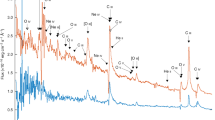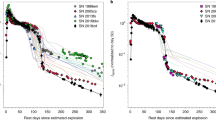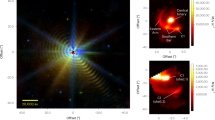Abstract
The explosive fate of massive Wolf–Rayet stars1 (WRSs) is a key open question in stellar physics. An appealing option is that hydrogen-deficient WRSs are the progenitors of some hydrogen-poor supernova explosions of types IIb, Ib and Ic (ref. 2). A blue object, having luminosity and colours consistent with those of some WRSs, has recently been identified in pre-explosion images at the location of a supernova of type Ib (ref. 3), but has not yet been conclusively determined to have been the progenitor. Similar work has so far only resulted in non-detections4. Comparison of early photometric observations of type Ic supernovae with theoretical models suggests that the progenitor stars had radii of less than 1012 centimetres, as expected for some WRSs5. The signature of WRSs, their emission line spectra, cannot be probed by such studies. Here we report the detection of strong emission lines in a spectrum of type IIb supernova 2013cu (iPTF13ast) obtained approximately 15.5 hours after explosion (by ‘flash spectroscopy’, which captures the effects of the supernova explosion shock breakout flash on material surrounding the progenitor star). We identify Wolf–Rayet-like wind signatures, suggesting a progenitor of the WN(h) subclass (those WRSs with winds dominated by helium and nitrogen, with traces of hydrogen). The extent of this dense wind may indicate increased mass loss from the progenitor shortly before its explosion, consistent with recent theoretical predictions6.
This is a preview of subscription content, access via your institution
Access options
Subscribe to this journal
Receive 51 print issues and online access
$199.00 per year
only $3.90 per issue
Buy this article
- Purchase on Springer Link
- Instant access to full article PDF
Prices may be subject to local taxes which are calculated during checkout


Similar content being viewed by others
References
Crowther, P. A. Physical properties of Wolf-Rayet stars. Annu. Rev. Astron. Astrophys. 45, 177–219 (2007)
Filippenko, A. V. Optical spectra of supernovae. Annu. Rev. Astron. Astrophys. 35, 309–355 (1997)
Cao, Y. et al. Discovery, rise and progenitor of a stripped envelope supernova iPTF13bvn. Astrophys. J. 775, L7 (2013)
Eldridge, J. J., Fraser, M., Smartt, S. J., Maund, J. R. & Crockett, R. M. The death of massive stars - II. Observational constraints on the progenitors of type Ibc supernovae. Mon. Not. R. Astron. Soc. 436, 774–795 (2013)
Corsi, A. et al. Evidence for a compact Wolf-Rayet progenitor for the type Ic supernova PTF 10vgv. Astrophys. J. 747, L5 (2012)
Shiode, J. H. & Quataert, E. Setting the stage for circumstellar interaction in core-collapse supernovae II: wave-driven mass loss in supernova progenitors. Astrophys. J. 780, 96 (2014)
Hamann, W.-R., Gräfener, G. & Liermann, A. The Galactic WN stars. Spectral analyses with line-blanketed model atmospheres versus stellar evolution models with and without rotation. Astron. Astrophys. 457, 1015–1031 (2006)
Dessart, L. et al. Core-collapse explosions of Wolf-Rayet stars and the connection to type IIb/Ib/Ic supernovae. Mon. Not. R. Astron. Soc. 414, 2985–3005 (2011)
Ofek, E. O. et al. Supernova PTF 09UJ: a possible shock breakout from a dense circumstellar wind. Astrophys. J. 724, 1396–1401 (2010)
Osterbrock, D. E. & Ferland, G. J. Astrophysics of Gaseous Nebulae and Active Galactic Nuclei 47 (University Science Books, 2006)
Law, N. M. et al. The Palomar Transient Factory: system overview, performance, and first results. Publ. Astron. Soc. Pacif. 121, 1395–1408 (2009)
Gal-Yam, A. et al. Real-time detection and rapid multiwavelength follow-up observations of a highly subluminous type II-P supernova from the Palomar Transient Factory survey. Astrophys. J. 736, 159 (2011)
Denisenko, D. et al. Supernova 2013cu in UGC 9379 = PSN J14335897+4014207. Central Bur. Electr. Telegr. abstr. 3540. (2013)
Groh, J. H., Meynet, G., Georgy, C. & Ekstrom, S. Fundamental properties of core-collapse supernova and GRB progenitors: predicting the look of massive stars before death. Astron. Astrophys. 558, A131 (2013)
Niedzielski, A. & Skorzynski, W. Kinematical structure of Wolf-Rayet winds. I. Terminal wind velocity. Acta Astron. 52, 81–104 (2002)
Leonard, D. C., Filippenko, A. V., Barth, A. J. & Matheson, T. Evidence for asphericity in the type IIn supernova SN 1998S. Astrophys. J. 536, 239–254 (2000)
Hillier, D. J. An empirical model for the Wolf-Rayet star HD 50896. Astrophys. J. 63 (suppl.),. 965–981 (1987)
Ofek, E. O. et al. SN 2009ip: constraints on the progenitor mass-loss rate. Astrophys. J. 768, 47 (2013)
Chugai, N. N. Circumstellar interaction in type Ibn supernovae and SN 2006jc. Mon. Not. R. Astron. Soc. 400, 866–874 (2009)
Hachinger, S. et al. How much H and He is ‘hidden’ in SNe Ib/c? - I. Low-mass objects. Mon. Not. R. Astron. Soc. 422, 70–88 (2012)
Vink, J. S. et al. Wind modelling of very massive stars up to 300 solar masses. Astron. Astrophys. 531, A132 (2011)
Gräfener, G., Owocki, S. P. & Vink, J. S. Stellar envelope inflation near the Eddington limit. Implications for the radii of Wolf-Rayet stars and luminous blue variables. Astron. Astrophys. 538, A40 (2012)
Crockett, R. M. et al. The type IIb SN 2008ax: the nature of the progenitor. Mon. Not. R. Astron. Soc. 391, L5–L9 (2008)
Arcavi, I. et al. SN 2011dh: discovery of a type IIb supernova from a compact progenitor in the nearby galaxy M51. Astrophys. J. 742, L18 (2011)
Bersten, M. C. et al. The type IIb supernova 2011dh from a supergiant progenitor. Astrophys. J. 757, 31 (2012)
Van Dyk, S. D. et al. The progenitor of supernova 2011dh has vanished. Astrophys. J. 772, L32 (2013)
Ergon, M. et al. Optical and near-infrared observations of SN 2011dh - the first 100 days. Astron. Astrophys. 562, A17 (2014)
Arcavi, I. et al. Core-collapse supernovae from the Palomar Transient Factory: indications for a different population in dwarf galaxies. Astrophys. J. 721, 777–784 (2010)
Yaron, O. & Gal-Yam, A. WISeREP—an interactive supernova data repository. Proc. Astron. Soc. Pacif. 124, 668–681 (2012)
Rau, A. et al. Exploring the optical transient sky with the Palomar Transient Factory. Proc. Astron. Soc. Pacif. 121, 1334–1351 (2009)
Poole, T. S. et al. Photometric calibration of the Swift ultraviolet/optical telescope. Mon. Not. R. Astron. Soc. 383, 627–645 (2008)
Faber, S. M. et al. The DEIMOS spectrograph for the Keck II Telescope: integration and testing. Proc. SPIE 4841, 1657–1669 (2003)
Oke, J. B. et al. The Keck Low-Resolution Imaging Spectrometer. Proc. Astron. Soc. Pacif. 107, 375–385 (1995)
Ben-Ami, S. et al. Discovery and early multi-wavelength measurements of the energetic type Ic supernova PTF12gzk: a massive-star explosion in a dwarf host galaxy. Astrophys. J. 760, L33 (2012)
Ben-Ami, S. et al. The SED machine: a dedicated transient IFU spectrograph. Proc. SPIE 8446, 844686 (2012)
Yoon, S.-C., Gräfener, G., Vink, J. S., Kozyreva, A. & Izzard, R. G. On the nature and detectability of type Ib/c supernova progenitors. Astron. Astrophys. 544, L11 (2012)
Li, W. et al. Nearby supernova rates from the Lick Observatory Supernova Search - II. The observed luminosity functions and fractions of supernovae in a complete sample. Mon. Not. R. Astron. Soc. 412, 1441–1472 (2011)
Walborn, N. R. et al. The spectrograms of Sanduleak −69°202, precursor to supernova 1987A in the Large Magellanic Cloud. Astron. Astrophys. 219, 229–236 (1989)
Niemela, V. S., Ruiz, M. T. & Phillips, M. M. The supernova 1983k in NGC 4699 - clues to the nature of type II progenitors. Astrophys. J. 289, 52–57 (1985)
Phillips, M. M. et al. The light curve of the plateau type II SN 1983K. Proc. Astron. Soc. Pacif. 102, 299–305 (1990)
Acknowledgements
This research was supported by the I-CORE programme ‘The Quantum Universe’ of the Planning and Budgeting Committee and The Israel Science Foundation. A.G.-Y. acknowledges support by grants from the ISF, BSF, GIF, Minerva and FP7/ERC, and a Kimmel Investigator award. M.M.K. acknowledges support from Hubble and Carnegie-Princeton fellowships. E.O.O. acknowledges the Arye Dissentshik Career Development Chair and a grant from the Israeli MOST. J.C.W. is supported in part by the NSF. J.M.S. is supported by an NSF Postdoctoral Fellowship. A.V.F. acknowledges financial support from the TABASGO Foundation, the Richard and Rhoda Goldman Fund, the Christopher R. Redlich Fund and the NSF. The National Energy Research Scientific Computing Center, supported by the Office of Science of the US Department of Energy, provided staff, computational resources and data storage for this project. The Oskar Klein Centre is funded by the Swedish Research Council. We thank K. Clubb, O. Fox, P. Kelly, S. Tang and B. Sesar for their help with observations, and J. Groh, P. Crowther, M. Bersten, C. Fransson and E. Nakar for advice. Some of the data presented here were obtained at the W. M. Keck Observatory, which is operated as a scientific partnership among the California Institute of Technology, the University of California and NASA. The observatory was made possible by the generous financial support of the W. M. Keck Foundation.
Author information
Authors and Affiliations
Contributions
A.G.-Y. initiated the study, conducted analysis and wrote the manuscript. I.A. found the supernova, triggered rapid follow-up spectroscopy and contributed to light-curve analysis, observations, data reduction and manuscript preparation. E.O.O. contributed to analysis of early-time data, mass loss estimates, temperature evolution and manuscript preparation. S.B.-A. contributed to data reduction and to early light-curve and spectroscopic analysis. S.B.C. reduced Swift and Palomar 60-inch data, and contributed to spectroscopic reduction and analysis. M.M.K. provided APO data and contributed to manuscript preparation. Y.C. contributed to APO data reduction, early light-curve analysis and manuscript preparation. O.Y. contributed to observations and manuscript preparation. D.T. provided unpublished supernova light-curve templates and contributed to photometric analysis. J.M.S. provided spectroscopic reduction and advice, and contributed to HET spectroscopy. A.H. provided early Keck spectroscopy. A.D.C. contributed to observations and data reduction. F.T. reduced NOT data. J.S. provided NOT spectroscopy. D.P. provided Keck spectroscopy and conducted analysis. P.M.V. assisted with observations, spectroscopic analysis, and figure and manuscript preparation. P.E.N. is a PTF builder and contributed to the manuscript. S.R.K. is a PTF builder. A.V.F. provided Keck data and edited the manuscript. J.C.W. provided HET data.
Corresponding author
Ethics declarations
Competing interests
The authors declare no competing financial interests.
Extended data figures and tables
Extended Data Figure 1 The r-band light curve of SN 2013cu.
A parabolic model of the flux–time (red solid curve) describes the pre-peak data (1σ error bars) very well. Backward extrapolation indicates an explosion date of utc 2013 May 2.93 ± 0.11 (MJD = 56414.93; 5.7 h before the first iPTF detection; see inset); we estimate the uncertainty from the scatter generated by modifying the subset of points used in the fit. Our first Keck spectrum was obtained about 15.5 h after explosion (vertical dotted line). Early Swift ultraviolet photometry (diamonds) places a lower limit of T = 25,000 K on the black-body temperature measured 40 h after explosion.
Extended Data Figure 2 Flash spectroscopy: rapid spectroscopic observations of supernovae during or shortly after shock breakout.
This simulated SEDM spectrum (red) created by downgrading the observed Keck spectrum (black; resolution, R = 2,000) to the coarse SEDM resolution (R = 100) shows that the strong Wolf–Rayet lines (in this case the marked H, He and N lines) are still easily detectable and allow us to determine the Wolf–Rayet spectroscopic class. The SEDM is an IFU low-resolution spectrograph designed for robotic response to transient events, to be mounted on the Palomar 60-inch telescope almost continually. Responding to real-time triggers from the iPTF survey operating on the same mountain, this instrument should be able to obtain low-resolution spectra within ∼1 h of object detection. Because SEDM operates on a smaller telescope than Keck, SEDM data of similar quality to the simulated spectrum will require a relatively long integration. However, SEDM will be able to observe objects with much reduced latency, thus benefiting from stronger line intensities expected from the stronger shock breakout flash luminosity processed by a denser wind close to the progenitor star, potentially compensating for its reduced absolute sensitivity.
Extended Data Figure 3 Comparison with early ‘Wolf–Rayet’ spectra of SN 1998S.
Wolf–Rayet-like features similar to those we observed were previously noted in two cases, SN 1983K (refs 39,40) and SN 1998S (ref. 16), and persisted for many days after explosion. The spectra of SN 1983K, classified as a type II-P supernova, are unfortunately not available for comparison. Spectra of SN 1998S (type IIn) are shown here. The spectra have a similar blue continuum slope and a similar Hα profile. The He ii λ5,411 and the N iv λ7,115 complex are weaker in SN 1998S, and the strong lines of N and C (5,806 Å) are broad, consistent with an origin in shocked CSM16 rather than in an undisturbed Wolf–Rayet wind. The inset shows a close-up view of the strong N iv λ7,115 complex. N emission from SN 1998S is weak compared with He i λ7,065 and shows a smooth, broad profile, whereas SN 2013cu exhibits a broad base (full-width at half-maximum, 2,500 km s−1) as well as strong and narrow (unresolved) N iv lines. These observations are consistent with an origin for the N emission of SN 1998S in shocked (and perhaps N-rich) CSM16, whereas the narrow He i lines may come from a more distant, photo-ionized wind. In SN 2013cu even the narrow N lines are much stronger than He, indicating a wind with a Wolf–Rayet-like composition at all radii.
PowerPoint slides
Rights and permissions
About this article
Cite this article
Gal-Yam, A., Arcavi, I., Ofek, E. et al. A Wolf–Rayet-like progenitor of SN 2013cu from spectral observations of a stellar wind. Nature 509, 471–474 (2014). https://doi.org/10.1038/nature13304
Received:
Accepted:
Published:
Issue Date:
DOI: https://doi.org/10.1038/nature13304
This article is cited by
-
A 12.4-day periodicity in a close binary system after a supernova
Nature (2024)
-
A WC/WO star exploding within an expanding carbon–oxygen–neon nebula
Nature (2022)
-
Unveiling the faint ultraviolet Universe
Experimental Astronomy (2021)
-
The electron-capture origin of supernova 2018zd
Nature Astronomy (2021)
-
New regimes in the observation of core-collapse supernovae
Nature Astronomy (2019)
Comments
By submitting a comment you agree to abide by our Terms and Community Guidelines. If you find something abusive or that does not comply with our terms or guidelines please flag it as inappropriate.



